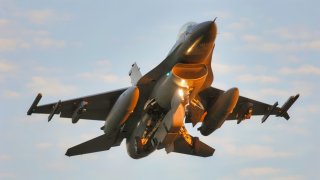32 Greek F-16 Fighters Could be Headed to Ukraine: They Won't Beat Russia Alone
Greece is reportedly considering transferring up to 32 F-16 Fighting Falcons to Ukraine, with potential discussions around also providing two dozen Mirage 2000-5 fighters. But it won't win the war for Kyiv.
Summary: Greece is reportedly considering transferring up to 32 F-16 Fighting Falcons to Ukraine, with potential discussions around also providing two dozen Mirage 2000-5 fighters. Amidst a "radical" overhaul aimed at modernizing its forces for the 21st century, Greece's Defense Minister highlighted the impracticality of maintaining such a diverse and dated fleet. This overhaul includes F-16 upgrades, expanding the Rafale fleet, and plans to acquire F-35 Lightning IIs, subject to U.S. approval. Meanwhile, Ukraine eagerly awaits the F-16s, seeing them as crucial despite acknowledgments that they may not be game-changers. Delays have sparked concerns about their timely effectiveness, and experts and officials temper expectations, suggesting that while valuable, the jets alone won't decisively alter the battlefield dynamics. This scenario underscores the complexities of modern military aid and defense strategies within the context of ongoing conflicts and geopolitical shifts.
F-16 Fighters: What Ukraine Wants and What Greece Could Give
NATO member Greece could transfer up to 32 of its F-16 Fighting Falcons to Ukraine, and there are also reports that the Hellenic Air Force could also provide its two dozen French-made Mirage 2000-5 fighters as well.
As previously reported, Athens is undergoing what it has called a "radical" overhaul of its armed forces, prioritizing a thorough reassessment of its air force. This has included a substantial transformation of its air force, and Greece is now planning to decommission and sell part of its diverse fleet of combat aircraft in an effort to modernize and streamline military capabilities for the 21st century.
"We have a cartload of different types of aircraft," Greek Defense Minister, Nikos Dendias, told Greek television late last month. "We have F-4s, Mirage 2000-5s, Block 30 F-16s, Block 50 F-16s, Block 52 F-16s, Viper F-16s and Rafales. We cannot carry on this way."
The transition includes upgrading the remaining F-16s to the more advanced Viper configuration and expanding its Rafale fleet from 24 to 30 units. Additionally, Greece is looking to bolster its air force with 40 state-of-the-art F-35 Lightning IIs, pending U.S. Congressional approval. This overhaul not only aims to enhance Greece's defense posture but also presents opportunities for other nations, like Ukraine, which might acquire some of the decommissioned aircraft to strengthen their own military capabilities.
Ukraine Wants the F-16 – But Will It Be Enough?
The F-16 Fighting Falcon has long been top of the list of military hardware platforms requested by Kyiv, and while Denmark, the Netherlands, and Norway have pledged to provide upwards of 65 aircraft, those first of those planes won't arrive until at least this summer.
"All Ukrainians are waiting for the day when the first Ukrainian F-16s will appear in our skies," Ukrainian President Volodymyr Zelensky said in February.
The delays in the F-16s reaching Ukraine could limit their effectiveness. Earlier this month, an anonymous Ukrainian senior military officer told Politico that "F-16s were needed in 2023; they won't be right for 2024."

The official added that the anti-tank missiles supplied by the UK and the U.S. in the early weeks of the war proved decisive for Kyiv's forces. By contrast, the long delays of some weapons – such as the Western main battle tanks (MBTs) that only arrived last year – made them less significant a weapon system on the battlefield.
For those reasons, the F-16 shouldn't be seen as a game-changer.
Experts suggested to Newsweek that the number of fighter jets Ukraine could operate may be far too small to make a strategic difference across the entire front line, especially as Russia has likely made use of the months since the donations of the jets were unveiled to prepare. The F-16 Fighting Falcon is a capable aircraft but it would be an "absolute magnet for Russian air defenses and Russian aircraft," warned Frank Ledwidge, senior lecturer in Law and War Studies at Portsmouth University in the U.K. and a former British military intelligence officer.
NATO Secretary General Jens Stoltenberg has also sought to temper expectations on what the jets could accomplish. He said that while the F-16s could expand the capability of the Ukrainian military, the aircraft likely won't be enough to radically affect the situation in the combat zone.
"A single system can't change the situation on the battlefield," said Stoltenberg, according to a report from Ukrainska Pravda. "This isn't a silver bullet that could change the course of the war. Yet the F-16s are important. They will strengthen Ukraine's ability to repel Russian aggression even more."
Author Experience and Expertise: Peter Suciu
Peter Suciu is a Michigan-based writer. He has contributed to more than four dozen magazines, newspapers, and websites with over 3,200 published pieces over a twenty-year career in journalism. He regularly writes about military hardware, firearms history, cybersecurity, politics, and international affairs. Peter is also a Contributing Writer for Forbes and Clearance Jobs. You can follow him on Twitter: @PeterSuciu.
You can email the author: [email protected].
Image Credit: Shutterstock.


